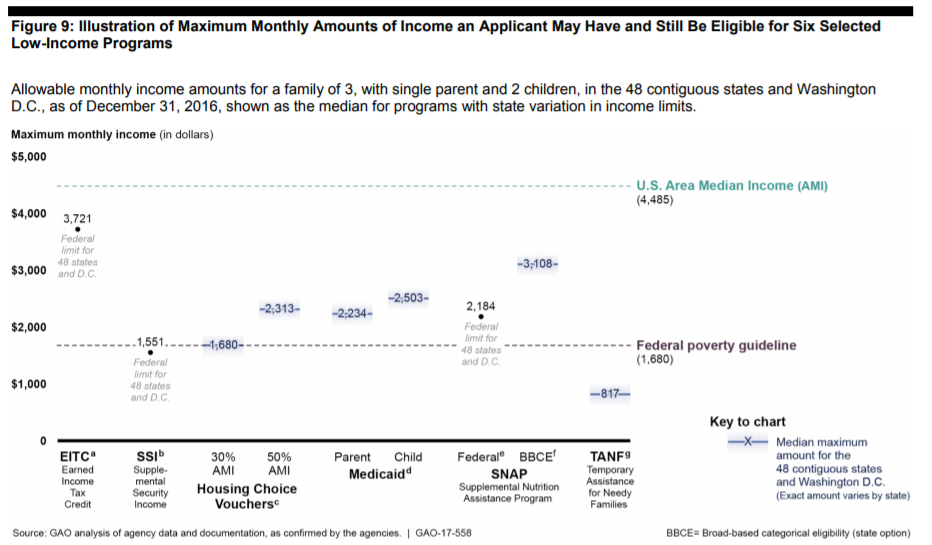The federal government spends more than $540 billion annually on a half dozen low-income assistance programs ranging from food stamps, housing vouchers and Supplemental Security Income (SSI) to Medicaid and earned income tax credits.
Many of these programs have long been susceptible to fraud and improper payments, especially the EITC, food stamps and the Medicaid program for low-income and disabled Americans. In 2014 alone, 22 federal agencies approved improper Medicare and Medicaid and EITC payments for working poor families totaling $124.7 billion, a 15 percent increase over the previous year.
Related: Feds’ Big Bust: $1.3 Billion Health Insurance Fraud Takedown
Critics frequently blame staggering levels of improper payments on bureaucratic incompetence and widespread fraudulent activity by beneficiaries and others – and there’s much truth to that. But a new report by the Government Accountability Office (GAO) released Friday blames part of the problem on the unduly complicated and confusing rules of these six programs that have baffled applicants and added enormously to the administrative burden of federal and state agencies.
The scathing report points to a hodge-podge of eligibility rules, definitions, allowable deductions and conflicting federal and state jurisdictions that render the network of cash and non-cash assistance programs a nightmare to manage.
“The numerous financial and nonfinancial eligibility rules for federal low-income programs can confuse applicants and increase program administration challenges,” according to the GAO report, which was commissioned by Senate Budget Committee Chair Mike Enzi (R-WY).
“For applicants, these rules have sometimes made it difficult and burdensome to navigate the application process for some programs,” the report said. “For program staff, separate rules for each program mean that staff has to keep track of and apply different rules when determining eligibility.”
Related: Medicaid Fraud Climbed to a Whopping $29 Billion Last Year
In undertaking the study, the GAO analyzed and compared the target populations and rules for determining eligibility and benefits across six of the biggest federally-funded programs for low-income people.
Those six included the refundable Earned Income Tax Credit (EITC) for working poor families; Medicaid health coverage for the poor and disabled; the Housing Choice Voucher program to assist low income people find suitable housing; the Supplemental Nutrition Assistance Program (SNAP) or food stamps; Supplemental Security Income (SSI) for the elderly, blind and disabled; and Temporary Assistance for Needy Families (TANF) to assist poor families in caring for children in the home.
Most of these programs lack the ability to share data and therefore must collect duplicate applicant information, which greatly adds to the time of processing applications. Moreover, there is no standard definition of what constitutes a “family” or “household,” and there is no standard definition of “countable income” or “allowable deductions” in determining eligibility.
While each program targets a somewhat different segment of the low-income population, there nonetheless is overlap – meaning that tens of millions of people may qualify for two or more of these programs based on their income. Yet the six means-tested programs vary widely in their eligibility requirements, especially in determining whether applicants are within the proper income levels.
Related: Crackdown on Medicare Fraud Is Producing Some Impressive Results
For example, when computing the income of an applicant for federal food stamps to determine whether he or she makes too much money, officials will include other benefits received through SSI and TANF, but not payments received through the EITC.
Similarly, officials count TANF benefits in determining whether an applicant for a Housing Choice Voucher falls within the acceptable income level, but not EITC, food stamps or SSI. Applicants for Medicaid coverage aren’t required to include any of those other benefits in computing their incomes in their applications, according to the GAO study.
What’s more, benefit levels also differ widely across the six selected programs. The average monthly benefits in fiscal 2015 ranged from $258 per month for food stamps to $626 for Housing Choice Vouchers, while the four other programs adjust their benefits annually.
Enzi said in a statement that the GAO report underscores the need for more efficient and effective government – something easier said than done.
“In an era of rising deficits and debt, Congress must consider how best to serve the needs of low-income Americans and hardworking taxpayers,” he said. “Standardizing eligibility and improving data-sharing in programs like these would be a good place to start.”
Related: 3 Government Programs That Are Dangerously in the Red
The GAO report says that “legal, administrative, and financial constraints” pose major obstacles to efforts to streamline varying eligibility rules for federal low-income programs.
“A key challenge is that the programs are authorized by different federal statutes enacted at different times in response to differing circumstances,” the report states. “Other laws, such as appropriations laws, can also have an impact on federal programs and their rules.”
That means that it would take sweeping changes in federal and state laws and vastly improved coordination among a broad set of lawmakers and congressional committees to achieve improvement in operating these programs.
With all that Congress and the Trump administration have on their legislative plate, including health care, taxes, infrastructure, and the debt ceiling, untangling the mess surrounding federal and state low-income assistance programs seems far down the totem pole.






